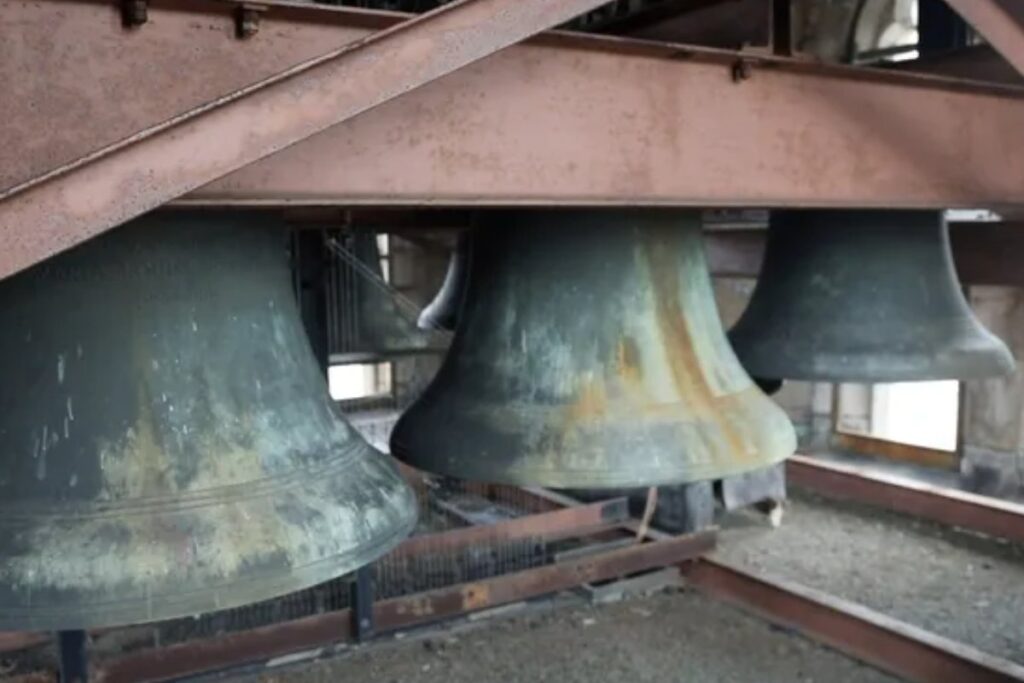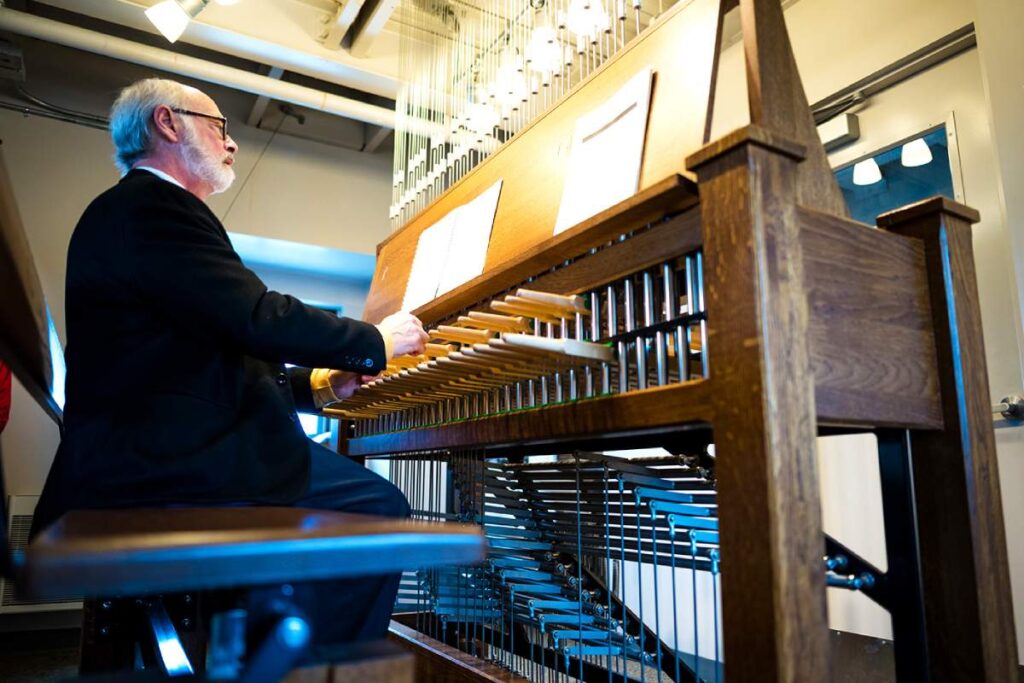A Comprehensive Look at The History of The Carillon

History Of the Carillon
The history of the carillon will take us to the realm of ancient music, where a truly special instrument called the Carillon exists.
Its powerful sound of this instrument has graced town squares, cathedrals, and historic places for centuries, enchanting all who hear its beautiful tunes.
The history of the Carillon is a fascinating and diverse journey spanning century. It encompasses its beginnings in the Middle Ages and phases of growth and decline.
An extraordinary resurgence was propelled by dedicated individuals and organizations committed to preserving this distinctive musical instrument.
This blog post will take us on a journey through time, where we will uncover the incredible history of the carillon.
We will start from its humble beginnings and trace its evolution into the magnificent instrument it is today.
This journey illustrates how music and human creativity can endure and flourish over time. So, join us as we step back in time to explore the carillon’s history.
Origins Of The Carillon

Carillon history stretches back to the days known as the Middle Ages, a time of great adventures and ancient tales.
Back then, people used bells in two very important ways: to send messages and to tell the time.
Imagine that bell ringers would tie ropes to the clappers of these big bells and make them chime, even though the bells themselves did not move.
This technique, called chiming, gave them better control, especially when they needed to send important messages.
For example, chiming bells were like alarms, warning everyone about fires or upcoming attacks.
When celebrations came around, bell ringers would gather the ropes and make the multiple bells chime in special rhythms.
As early as the 15th century, they started to use this technique to make music with the bells.
There was a story from way back in 1478 about a man in Dunkirk who figured out how to play melodies on the bells in a new way.
And in 1482, there was another tale about a jester from Aalst who played bells in Antwerp using ropes and sticks.
This gives us a hint that something like a keyboard might have existed even then. Imagine that!
Mechanical Clock

In the 14th century, something really interesting happened.
A new technology called escapement came along and changed everything.
The water clocks that were used to tell the time during that period were replaced with mechanical clocks in European clock towers.
These early clocks did not have the clock faces we are used to seeing today.
Instead, they told the time by ringing a bell a certain number of times to show what hour it was.
As time went by, people made some changes to these ringing clocks.
They added a warning signal right before the hour to let everyone know something important was about to happen.
This signal was called the forestrike. At first, it would ring one or two bells, but it got more complex as time passed.
By the middle of the 15th century, forestrikes could play simple tunes using three to seven bells.
Imagine that! It was like having a little concert right there in the clock tower.
Then, around 1510, something even cooler happened. They figured out how to do two things at once: send messages and keep track of time.
They did this by creating something called a primitive carillon in the Oudenaarde Town Hall.
This special set-up had nine bells connected to both a keyboard and the clock’s forestrike.
All of this happened in a place called the Low Countries. That is the area we now know as Belgium, the Netherlands, and a part of France.
They were really ahead of the game when it came to making bells. They knew how to make them better than anyone else in Europe.
Carillon History and Development

In the 17th century, something really exciting happened in the world of carillons.
You see, in a place called the Low Countries, the people who made bells found themselves getting more and more support.
This was all thanks to the bustling sea trade happening through their ports. It was like a boost of energy for their bell-making skills!
And guess what? The leaders of the time, like Margaret of Austria and Holy Roman Emperor Charles V, brought a lot of wealth and power to the cities in that area.
This meant big things for carillons. They became these super fancy symbols of city pride.
It was like a friendly contest between cities to see who could have the biggest and fanciest carillon.
The families who were really good at making bells, like the Waghevens and Vanden Gheyns, were super busy.
They crafted more than 50 carillons during the 1500s and early 1600s. That is a lot of bells!
By the year 1600, the carillon was not just a new idea anymore. It had become a regular and important part of life in that region.
People could not imagine their cities without the sweet melodies of those bells ringing out.
A Pivotal Development in the Modern Carillon
In the 17th century, something really important happened that changed carillons forever.
It was all thanks to a special team: the Hemony brothers, Pieter and François, who were experts at making bells, and a talented carillonneur named Jacob van Eyck.
Pieter and François Hemony were known far and wide for their amazing skill in tuning bells just right.
And Jacob van Eyck, even though he could not see, had a special gift for understanding how bells should sound.
In 1633, he figured out how to listen carefully to a bell and describe all the different sounds it made.
He also learned how to make the bell sound just right by adjusting its thickness.
Then, in 1644, something really exciting happened. The Hemony brothers were asked to make 19 bells for a tower in Zutphen.
In the process, they asked Jacob van Eyck for advice. With his help, they tuned the bells just the way he suggested.
That set of bells became the very first carillon as we know it today.
From that moment on, they set a standard for carillons. They said that every carillon should have at least 23 bells, and that is still the rule today.
Over the next 36 years, the Hemony brothers went on to make a whopping 51 carillons. The love for carillons really flourished during this time. It was like a carillon renaissance!
The History of Carillon Declination

Following the tumultuous era of the French Revolution, the carillon experienced a significant decline.
This period marks a pivotal moment for the Low Countries and their cherished bell instruments.
With the annexation of the Austrian Netherlands in 1795 and the United Provinces in 1810, the French administration campaigned to repurpose local carillons.
This campaign was initiated in response to a critical shortage of copper.
They even went as far as publishing detailed instructions on how to extract this precious metal from bell bronze.
Despite this, resilient carillon owners took a stand. They petitioned the newly established governments, advocating for their instruments to be recognized as “culturally significant.”
To safeguard the cultural significance of the bells, some took extensive measures to hide their bells in secret.
At the time, there were as many as 110 carillons in existence. Yet tragically, nearly half of them were lost due to the ravages of war, destructive fires, and deliberate dismantling.
The majority of the remaining instruments met a somber fate, being melted down to forge cannons for the French Revolutionary Wars.
Between 1750 and the late 19th century, the carillon’s popularity dwindled.
This was due to the rise of grandfather clocks and pocket watches, which took over as the primary timekeepers.
Musically, the carillon fell behind the expressive styles of the Romantic era.
Many carillons were tuned in a way that did not fit the chromaticism of newer music trends.
Moreover, there was a lack of new musical compositions specifically designed for carillons.
The skill level of carillonneurs also declined significantly. In fact, by 1895, a music publisher pointed out that “no carillonneur of our time knows how to play them on the carillon.”
The once-prized tuning techniques pioneered by the Hemony brothers were forgotten. This results in lower-quality carillons being made later on.
The History of the Carillon Revival
In the early 1890s, the carillon’s renaissance took root with Arthur Simpson, an English bell expert.
He wrote articles critiquing bell tuning techniques and suggesting improvements.
John William Taylor, also striving to master the Hemony brothers’ methods, teamed up with Simpson.
Together, in 1904, they cast the first precisely tuned bells in a hundred years, igniting a revival in carillon craftsmanship.
In Mechelen, Belgium, Jef Denyn played a pivotal role in revitalizing the carillon as a musical marvel.
Assuming the position of city carillonneur in 1887, he set out to enhance the instrument’s performance.
Denyn ingeniously devised the tumbler rack system of transmission cables, which improved control over dynamics, rapid passages, and tremolos.
These tremolos addressed the carillon’s challenge of sustaining individual notes in an expressive manner.
Consequently, Denyn’s concerts drew sizable crowds, and by 1892, he had established regular Monday night performances.
This firmly establishes the carillon as a concert-worthy instrument.
Impact of the World Wars in the History Of Carillon
The impact of World War I and World War II on carillons was profound and devastating.
These conflicts resulted in the widespread destruction of carillons, cherished as distinctive democratic musical treasures.
The loss was widely reported among Belgium and the Netherlands’ allies.
Throughout World War II, Germany confiscated a substantial number of bells from both countries.
This totaled about 150,000 bells, which were then sent to foundries and melted down for their valuable copper.
In the aftermath of the war, bells were removed from their towers. This allowed scholars like E. W. Van Heuven to scrutinize their tonal characteristics in controlled laboratory settings.
Percival Price, the Dominion Carillonneur at the Peace Tower, played a pivotal role in bringing back surviving bells and conducting further research.
This era sparked a resurgence in the creation of new carillons, as bellfounders across the board could now glean the knowledge needed to cast top-quality bells.
Carillon Movement in North American History

From 1922 to 1940, a total of 43 carillons found their way into the United States and Canada.
This surge was thanks to the efforts of William Gorham Rice, a government official hailing from Albany, New York.
He had encountered carillons in his travels and authored books about them, which gained immense popularity.
Inspired by his writings, affluent patrons stepped forward to acquire carillons for their towns.
This wave of enthusiasm paved the way for the appointment of professional carillonneurs like John William Price and Mary Mesquita Dahlmer. This happened not only in the United States but also in Canada.
In 1936, the Guild of Carillonneurs in North America was established in Ottawa, Canada. This reflected a rising interest in carillon music and performance.
Following the passing of influential figures like Jef Denyn in 1941 and William Gorham Rice in 1945, North American carillonneurs aimed to solidify their own educational and performance authority. They sought to do so through this organization.
The 1950s and 1960s witnessed the emergence of a distinct North American style of carillon music, centered at the University of Kansas.
Guided by Ronald Barnes, the university’s carillonneur, fellow musicians were inspired to compose specifically for the carillon.
This resulted in the creation of numerous original pieces.
International Recognition Of the Carillon
During the 1970s, the World Carillon Federation emerged as the global hub for carillon enthusiasts and players.
It brought together national and regional carillon associations established in the 20th century.
In 1999, UNESCO bestowed World Heritage status upon 32 bell towers in Belgium, acknowledging their architectural importance and variety.
This list grew in 2005 to encompass 23 towers in France, along with the tower of Gembloux, Belgium.
Then, in 2014, UNESCO officially recognized Belgium’s carillon culture as an intangible cultural heritage.
This highlighted the imaginative work of carillonneurs and their positive impact on local communities.
The carillon made its mark in popular culture. Notably, it featured prominently in the 2008 film “Welcome to the Sticks. This film became the highest-grossing French film of its time.
In 2019, the Irish government officially acknowledged playing the carillon of St. Coleman’s Cathedral in Cobh, Ireland, as a crucial aspect of the nation’s living cultural heritage.
Final Note
The history of the Carillon is an enthralling saga that spans countless centuries.
Emerging from modest roots in the Middle Ages, it weathered phases of both growth and decline.
However, its later resurgence stands as a tribute to human tenacity and creativity.
Contemplating this bountiful history, we’re reminded of the profound influence that fervent individuals possess in protecting and cherishing our cultural gems for posterity.
Passionate individuals and committed organizations have toiled ceaselessly to safeguard this extraordinary musical instrument, ensuring the carillon’s legacy perseveres.
In present times, carillons echo their melodies globally, serving not only as emblems of cultural heritage but also as potent channels of musical expression.
At Phamox Music, we go all out for exactness and honesty. For this purpose, if by any means you found any possible glitch, be it factual, editorial, or something that we need to update, kindly contact us.
If you find the information provided in this post “History Of Carillon” interesting and helpful, kindly share it with someone you know that might need it.







